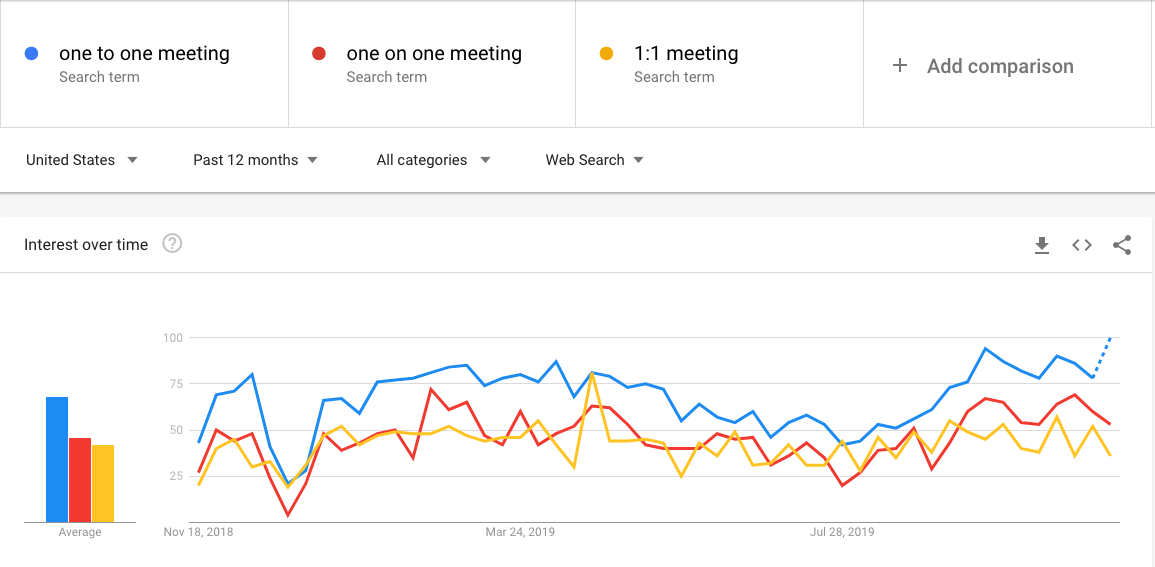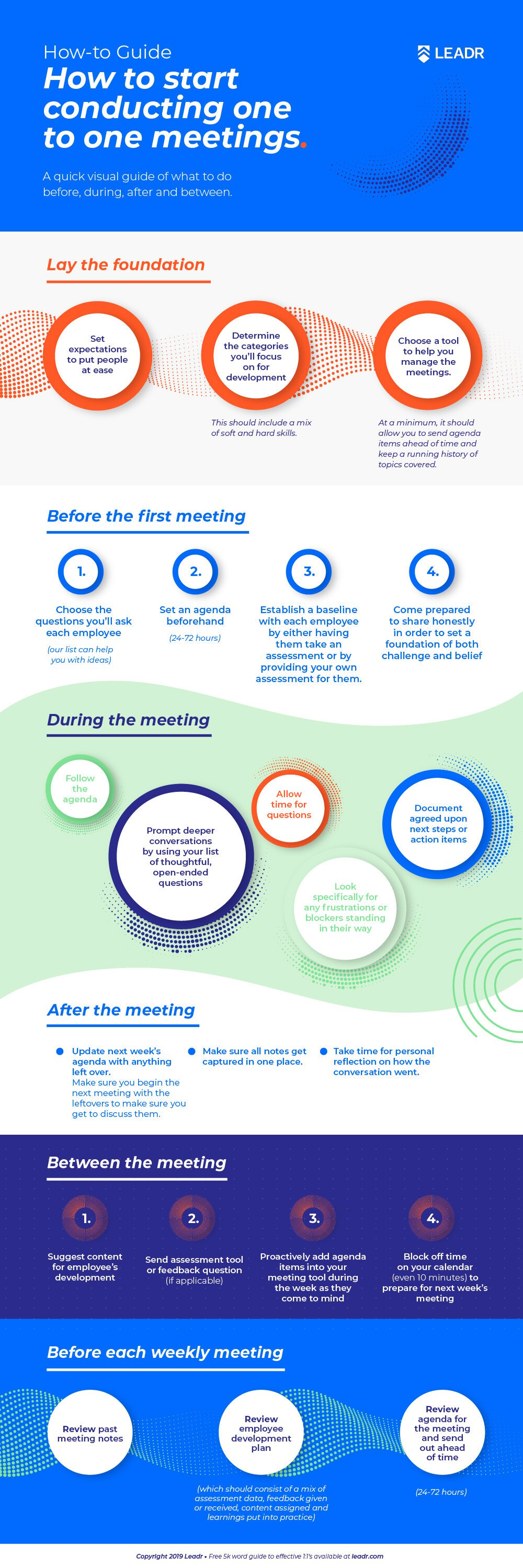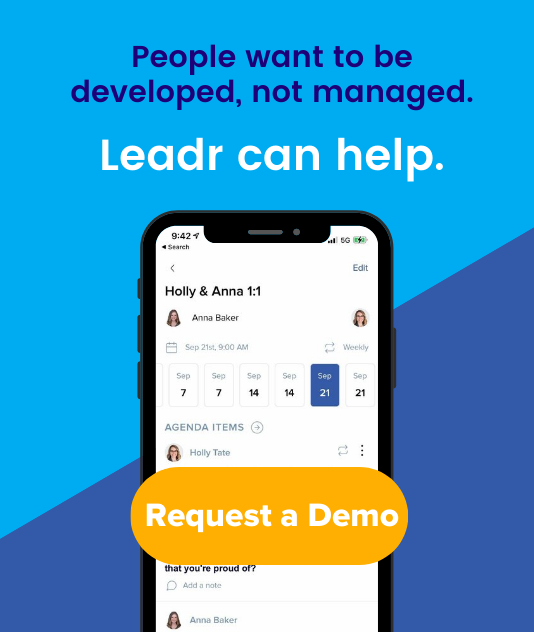How-to Guide: The One to One Meeting
How-to Guide: The One to One Meeting
While most of us have heard the term “one on one meeting,” many still remain unaware of the power this meeting holds to enact meaningful change in both company culture and employee performance.
Reading the latest leadership book or following the trendy thought leader may be more appealing, but we strongly urge all managers (both first time and seasoned executives) to put aside the new and consider a return to the fundamental tactic of the weekly check-in.
Yet, simply conducting weekly 1:1 meetings isn’t enough (we’ll get into this in more detail later). One study from MetrixGlobal LLC proved a 529% ROI from regular 1:1 meetings, but only when those meetings were defined by consistent employee coaching. From the executive summary of the study, “The bottom line: coaching produced a 529% ROI (that’s $5 for every $1 spent on coaching) as well as significant intangible benefits to the business.”
This guide is written to be a comprehensive tutorial for managers and organizational leaders on the one on one meeting, broken out into two main sections.
The first part of this guide will teach you about the fundamentals of the one on one meeting: what it is, why they are important, etc. Scroll down below to begin reading.
The second half will help you to tactically execute on putting this important management practice into play. We also include a step by step template to get you started. If you prefer to skip ahead, use the table of contents below to skip down to the chapter of your choice.
Still wondering if this guide is worth your time? Consider these common scenarios:
-
“I’m a first-time manager and I have no clue how to structure a one on one meeting.” Don’t worry, we’ll walk you through everything you need to know.
-
“I’ve recently been promoted and I want to set strong routines in place right away to earn the respect of my team and build a healthy culture going forward.” Kudos! This guide can help you get started.
-
“I’ve been a manager for a very long time, but I can’t say I’ve ever felt like much of a coach, especially when it comes to weekly employee meetings.” It’s not too late to change! We cover this specific scenario later on in the guide. Keep reading.
Let’s get started.
Table of contents
Section One - the Basics
-
Definition: What is a One on One Meeting?
-
Why Are They Important?
-
How to Make Them Effective
Section Two - Strategy & Tactics
-
Choosing the Best Format (length, setting, frequency)
-
How to Set the Agenda
-
Knowing Which Questions to Ask During the Meeting
-
Tools for and Importance of Documentation
-
Free Downloadable Template
-
“But what if…” Key Scenarios and How to Deal with Them
Section One: Basics, Definitions, Importance and Effectiveness
What is the One to One Meeting
Simply put, the one to one meeting is designated time between a manager and their individual direct reports on a consistent basis.
As a leader and/or manager, your primary responsibility is to build teams that execute the vision of your organization. With this in mind, one on ones provide the ideal space for you to give guidance, provide empowerment, a listening ear, and coaching at an individual level to each member of your team. In short, use this time to do three primary things with your team:
-
Teach and reinforce the vision and standards of the organization.
-
Strategize execution and review feedback from past results.
-
Provide coaching and conversation, to show your team that you care about them as people.
“As a marathon runner, I think of 1:1s as a way to ensure we are aligned on the best path to achieve the goal, as well as a point to pick up water to hydrate to ensure we are prepared to go the distance.” - Mark Hawkins, CFO, Salesforce
Is it one to one, one on one, or 1:1 meeting?
Hopefully, this section will help you to answer an arbitrary debate over the most correct version of the term. After scouring the internet, it seems the world is divided on a single correct terminology, which is why you’ll see us use a mix of terms throughout this article. However, Google keyword trends show one to one meeting as the most popular version of the phrase. Beyond popularity, here’s some additional guidance: Use 1:1 for brevity and one to one meeting for clarity.

Why are One to One Meetings Important
Every leader wants to see both growth and engagement from their staff. The way this is measured may fluctuate from organization to organization: productivity, retention, revenue targets, performance evaluations, etc. However, we believe the single biggest driver of increased growth, engagement, and productivity is the relationship between the manager and the employee. This makes the one on one meeting incredibly important time, as it may be the only dedicated space all week where they have your undivided attention.
You’ve heard the quote “The way to be a great manager is to hire the right people and get out of their way.” Kim Scott, Author of Radical Candor says in response, “It’s kind of like saying ‘The way to have a great marriage is to marry the right person and never spend another minute with them.’ it’s not going to work.”
Additionally, Nathan Sloan (Deloitte) explains that today’s job market is dynamic and transparent. High-potential young employees want regular feedback and career progression advice, not just “once and done” reviews.
“The most important ingredient to engagement is to start the habit of meaningful and somewhat structured conversations around careers and provide people with indications of progress over time.” - Libby Stewart, Head of Professional Services & Research at 7Geese
Let’s touch on seven business-critical areas which can be positively impacted by a well-structured and documented one on one process:
Engagement
According to Gallup, less than one-third of Americans are actively engaged in their jobs at any given year and engagement is highest among employees who have some form of weekly communication with their managers. One on one meetings are directly linked to increasing employee engagement.
Communication
Without effective communication, the rest of your leadership skills fall flat. While it seems a simple task, oral communication continues to appear on the top of the greatest skill shortage lists, especially in large cities such as Washington D.C., San Francisco, and New York, making it a highly in-demand skill to possess. One on one meetings are a great time to work on your communication skills.
“Cultures where important things get left unsaid are unproductive, unpleasant, and frankly toxic to the business.” - Alex Turnbull, CEO & Founder of Groove
Coaching / Feedback
Coaches > Bosses. Coaches focus on the development of potential, while bosses worry primarily about task management. Development conversations happen best in environments where you can provide undivided attention. The one on one meeting works well in this regard. In this setting, you can see their body language, reactions, etc - which help you truly care and provide ongoing coaching.
“Positive attention is thirty times more powerful than negative attention in creating high performance on a team.” - Marcus Buckingham (Nine Lies About Work)
Did you know? Leadr has built-in personalized coaching tools to grow every employee and save you time.
Request a demo now.
Reinforce Culture & Vision (Alignment)
Most of the time culture and vision are cascaded down through large staff meetings or once a year at an offsite. Worse yet, they are expected to be learned or absorbed through osmosis. The reality is, reinforcing culture and vision works best one on one, with tangible examples, and the ability to quickly adjust. Rare but extremely powerful is a group of people who speak one language, with one shared destination. This becomes a force to be reckoned with.
“Culture eats strategy for breakfast.” - Peter Drucker
Strategize Execution (Updates)
Getting things done is the name of the game. It’s ultimately why we all go to work every day. The best managers know the top priorities for each of their staff and take on a coaching role to work with them to achieve their goals effectively. The one on one meeting is the perfect format to tackle not only the ‘what’ but also the ‘how,’ acting as the consistent touchpoint to make sure outcomes are on track.
Show You Care (Build Trust)
With constant change at organizations and the busyness of our schedules, it’s easy for team members to go unnoticed or feel left behind. One on ones disrupt this tendency by keeping an authentic relationship going. The strongest teams have a leader that shows authentically that they care. Curt Cronin, Co-founder and CEO of Ridgeline Partners says, “People don’t want work-fueled robots guiding their companies. They would much rather work for skilled, empathetic leaders who feel passionately about their missions, make honest mistakes and learn along the way.”
Empowerment
We have all experienced or observed a boss who was unable to give up control. According to Gallup, empowerment looks like your team being “energized”. A great time and place to begin empowerment is in one on one meetings. Empowering your team will also provide great side-effects like creating a positive work environment, saving time, and raising the ceiling of your organization’s potential.
“One of the biggest values of 1:1s is discovering where employees are struggling or stuck, and helping them find a path forward. Not by telling them how you’d do it, but by guiding them to come up with their own solution.” - Jon Plax, Senor Director, Customer Centric Engineering, Salesforce
But why continue reading?
Why take the time to have one on ones? Here are five cultural reasons to make the effort:
-
Millennials will make up 50% of the workforce by 2020, and 75% of the workforce by 2025. They now expect more from both their workplace and their manager. (Deloitte, Millennial Survey)
-
50% of staff plan to be with a different organization one year from now. (Gallup, State of the American Workplace Report)
-
Anecdotally, there is a shift where employees are looking for more than a stable paycheck, but rather for an environment where they can learn, grow and be valued for the ideas they bring to the table.
-
Only 15% of employees worldwide are actively engaged, and great managers create the right environment for engagement. (Gallup, State of the Global Workforce Report)
-
42% of employees say learning and development is the most important benefit when deciding where to work. (Udemy, 2018 Millennials at Work Report)
Many leaders fail to set aside time for one on ones, simply because it can be overwhelming to create a system and stick with it. But not you. Now that you know the importance of one on one meetings, we’ll walk you through the practical steps to begin conducting them.
How to Make One on One Meetings Effective
Remember our ROI statistic from earlier? Organizations realized a 529% ROI from regular 1:1 meetings, but only when those meetings were defined by consistent employee coaching. This sacred time is not effective when both parties are simply chit-chatting. Making one on one meetings effective really comes down to strategy.
Your strategy should consist of these parts, at a minimum:
-
Format: specifically length and setting
-
Frequency: consistency breeds trust because it shows you care
-
Agenda: the tool to manage it, preparation and asking the right questions
-
Documentation: one place to look back on agenda items, notes, and view progress
Below we’ll walk you through some working best practices, but be open to developing your own flow or style. Don’t be afraid to make adjustments to your strategy as you go.
How do you know if your 1:1 meeting strategy is effective? Look for these clues:
-
Level of engagement on your team is going up
-
Problems are solved faster
-
Alignment both in culture and execution of work
-
Increased open communication
-
Development with each employee
Section Two:
Strategy, Tactics, Format, Frequency, Agenda, Tools & Documentation
Choosing the Best Format for your 1:1 Meeting
First things first - make a game plan. Being prepared sets a tone of empathy, showing your team that you’ve made them and their growth a priority.
Length
The majority of one on ones range from twenty to sixty minutes. We believe 45 minutes is the sweet spot. It’s easy to keep track of three, fifteen-minute increments, and it cuts down on the risk of wasted time just to fill a full hour.
For example:
-
15 minute catch up and ask a meaningful conversation question
-
15 minute day-to-day updates / priorities
-
15 minute go over action items and any coaching/feedback
Setting
This may seem like common sense, but many managers do not provide a safe and secure environment to have one on one meetings. Not compromising on this shows your team you are compassionate and empathetic. This also will produce trust and candor in the meeting.
Some things to keep in mind:
-
Typically, it makes the most sense to hold one on one meetings in a private office, or conference room, with the door closed. This limits interruptions and protects privacy.
-
Other non-traditional options like a coffee shop, or while on a walk will also work. This may be a better fit for your culture or current office space set-up.
-
What feels safe and secure to you, may not feel safe or secure to them. Marcus Buckingham even goes so far as to suggest this, “To get the best coaching outcomes, always have your 1-on-1’s on your employee’s turf, not yours. In your office the truth hides.”
The goal is to create a comfortable, safe, and secure environment that is conducive to both honest and productive conversations.
Frequency
“Trust can never emerge from secrecy. Frequency creates safety.” - Marcus Buckingham
Industry leaders have one on one meetings once per week. Mark Zuckerberg, CEO at Facebook says, “...in the last eight years or so that we’ve worked together, where every week we start the week and end the week just meeting one-on-one together, and going over everything that’s going on, and reflect, giving each other feedback.”
Damon Schechter, CEO of Shipwire says weekly one on ones helped him build a culture of trust. Consistency ensures clarity on your team as everyone knows what to expect, which adds to the healthy culture that leaders are striving to create.
“And what happens when a manager doesn’t meet with employees one-on-one at all, or neglects to provide on-the-job training? Employees in this situation are four times as likely to be disengaged as individual contributors as a whole, and are two times as likely to view leadership more unfavorably compared to those who meet with their managers regularly.” - HBR
That said, Andy Grove, former Intel CEO, believed the frequency of one on ones should be dictated by the level of experience and knowledge of each employee. The more senior and more directly involved in a project, the greater the frequency a manager should meet with this employee.
Ultimately the decision is yours and should reflect the stage of the company, your culture and the pressing tasks at hand. We’ve even seen some companies ramp up frequency to once a week in order to get a better handle on a toxic culture or complicated project, but then wind down to every other week.
Did you know? Leadr helps by keeping all your one on one meetings in one dashboard, so you never have to struggle with calendar view or missing agendas again. Request a demo now.
How to Set the Agenda
With the amount of competing priorities and the busyness of your schedule, it will be tempting to just ‘show up’ to each one to one meeting. Winging it by responding on the fly to comments, recalling projects off the top of your head and expecting the employee to drive the bulk of the conversation and follow-up documentation afterward.
We can’t stress this enough - Don’t fall into this trap!
Instead, commit to preparation. This doesn’t have to eat up a huge amount of time, 15-30 minutes throughout the week should do it. At the very least, block out 10 minutes prior to each 1:1 meeting to review the agenda and prep some questions.
Ideally, both the manager and the employee will collaborate on the agenda ahead of the weekly meeting. This is easily accomplished with a tool like Leadr, where items and notes can be added and viewed during the week by both parties.
Referring back to our three, 15-minute chunk format, your agenda should leave room for:
-
Personal catch up and meaningful conversation
-
Review of top priorities and project updates
-
Action items, next steps and any coaching items
Additionally, work to incorporate the following types of content into your agendas:
-
Past meeting agendas
-
Feedback given or received
-
Assessments
-
Cultural or capability standards
-
Content for learning
-
Coaching or development plan progress
-
Positive recognition and celebration
Initially, we recommend the manager to run the meetings and set the agendas. Then, help your employees grow in maturity by slowing giving more and more of the meeting agenda over to them. This can help them improve their confidence, preparation, and communication skills. Demonstrate these skills in the way you initially lead the meetings so they can learn by example as well as by practice.
And while eventually, your employees may drive these meetings, never default away your role as coach. They still need to hear your feedback, encouragement, and direction. We suggest that it is the manager who always owns the responsibility for creating a meaningful conversation each week. An easy way to do this is by using our list of predetermined one on one questions.
Since this is such a key part of successful one to ones, we’ll dig into more detail on meaningful conversations in the next section.
Did you know? Leadr has predetermined questions available within the meeting agenda screen to make it easy for you to prompt a meaningful conversation. Request a demo now.
Knowing Which Questions to Ask During the One on One Meeting
Great coaching requires meaningful conversations.
And meaningful conversations start with great questions.
Unfortunately, employees are typically somewhat reserved from sharing the full truth outright with their manager. Dig beneath the surface as you create trust enough to get to the core of each person’s motivations, beliefs and frustrations by asking open-ended questions.
We suggest having your questions prepared ahead and shared with your direct reports so there are no surprises. You will find the conversation can go deeper because the employee had time to think and process beforehand.
Remember to temper your reaction to their potentially negative and surprising answers. Non-verbal cues speak volumes about whether you are a safe person for them to talk to. Are you actually committed to their development or is this just some new management ploy to weed out bad employees? Instead, follow this advice:
“As you facilitate the meeting, ask questions intended to move things forward. ‘How can we alleviate your concern? Is this plan something you can live with?’” - Al Pittampalli, Read This Before Our Next Meeting
Most importantly, remember to listen. Actually listen.
“Listening helps you handle conflict, express respect and be a better leader. Unfortunately, most people don’t remember because they don’t hear it in the first place.” - Cash Nickerson, author of The Samurai Listener.
Here are a few additional suggestions to get you started.
Begin with an Ice Breaker Question such as:
-
What’s on your mind?
-
What motivates you to come into work each day?
-
If money were no object, what would you do every day?
Then move into Day-to-Day Role Questions (can be project-specific):
-
What part of your job do you enjoy the most? And which part do you enjoy least?
-
What roadblocks or frustrations do you have that I could help resource you to eliminate?
-
Is everyone pulling their weight on the team?
Lastly, “see” them with Career-Centric Questions:
-
What are you doing really well that is helping you move towards your goals?
-
Are there any areas of your job that you would like additional training in?
-
Do you feel we’re helping you advance your career at a pace you would like? Why or why not?
“A focus on strengths increases performance. Therefore, a focus on strengths is what creates growth.” - Ashley Goodall, Nine Lies About Work
Finally, keep trying, don’t give up when it gets hard. Asking the right questions and demonstrating a healthy response to their answers takes practice. You will make mistakes and you may encounter situations beyond your leadership expertise. Use this opportunity to turn to a mentor for advice as you work on your own growth in the process.
The Best Tools for Documenting One on One Meetings
As our co-founder, Matt Tresidder constantly reminds us, “If it’s not written down, it didn’t happen.” Consistent documentation may seem tedious, but it has many benefits:
-
The practice of written communication skills
-
Better listening in the meeting
-
Easier to keep track of follow-up items
-
Helps show progress over time
-
Demonstrates to the speaker that they were heard
-
Creates a record in the unfortunate case of performance issues or terminations
-
Makes the annual performance review process more meaningful as a record of actual examples over time, rather than relying on fading memories or anecdotal impressions
In the one to one meeting, you’ll typically be looking to document what was discussed, action items and decisions made. As the manager, you’ll also want to include documentation around updates to the coaching plan, response to development topics and feedback given or received.
In terms of the specific tool, at a minimum, we recommend a collaborative, cloud-based, note-taking tool such as Google Docs or Evernote. A shared document like this is easily accessible whenever you need to reference it. It also promotes collaboration, which leads to preparation, and will keep some form of running history of meetings, with date stamps.
Relying solely on pen and paper may feel more personal than a technology solution, but any benefit gained is quickly lost when items slip through the cracks, opportunities for collaboration are lost, and essential notes vanish in the shuffle of paperwork.
Our Top Choice: We created Leadr to be an all in one place tool for employee development. Rather than shared docs in one place, meeting agendas in another and performance feedback in a third - Leadr acts as one seamless and intuitive system for all these things. Schedule meetings, collaborate on agendas, request feedback, assign content for learning, and more all in one place. Request a demo now.
Free Downloadable Template
Use this quick visual guide of what to do before, during, after and between the one on one meeting to get started conducting great 1:1’s.
Congratulations on making it this far. Now it’s time to put everything you’ve learned into practice. It can be hard to remember everything we talked about, so we’ve put together a quick visual guide for you to download which covers what to do before, during, after and in-between your one to one meetings.
Either bookmark this page for reference or right-click on the infographic and choose to save image. Now you can save this to your desktop or post it to your company blog. If you do share this image online, please link back to our original post.
Lay the foundation
-
Set expectations to put people at ease
-
Determine the categories you’ll focus on for development (this should include a mix of soft and hard skills)
-
Choose a tool to help you manage the meetings. At a minimum, it should allow you to send agenda items ahead of time and keep a running history of topics covered.
Before the first meeting
-
Choose the questions you’ll ask each employee (our list can help you with ideas)
-
Set an agenda beforehand (24-72 hours)
-
Establish a baseline with each employee by either having them take an assessment or by providing your own assessment for them
-
Come prepared to share honestly in order to set a foundation of both challenge and belief
During the meeting
-
Follow the agenda
-
Prompt deeper conversation by using your list of thoughtful, open-ended questions. It’s ok for these to get personal.
-
Allow time for their questions
-
Look specifically for any frustrations or blockers standing in their way
-
Document agreed-upon next steps or action items
After the meeting
-
Update next week’s agenda with anything left over. Make sure you begin the next meeting with the leftovers to make sure you get to discuss them.
-
Make sure all notes get captured in one place
-
Take time for personal reflection on how the conversation went
Between the meeting
-
Suggest content for employee’s development
-
Send assessment tool or feedback question (if applicable)
-
Proactively add agenda items into your meeting tool during the week as they come to mind
-
Block off time on your calendar (even 10 minutes) to prepare for next week’s meeting
Before each weekly meeting
-
Review past meeting notes
-
Review employee development plan (which should consist of a mix of assessment data, feedback given or received, content assigned and learnings put into practice)
-
Review the agenda for the meeting and send out ahead of time (24-72 hours)
"But what if..." Key Scenarios and How to Deal with Them
“I’m a young manager and most of my team is much older than I am.”
Don’t demand respect, but work to earn it with your patience, humility and clear vision. Technology may come naturally to you, but don’t get offended or frustrated if it takes them some time to get up to speed. Build a deep relationship by exhibiting respect for their experience. Demonstrate this respect by taking the time to ask them deep and meaningful questions to draw and learn from their past history. Don’t be afraid to hold them accountable, but be kind, patient and well-documented in the process. They may initially see you as ‘the same age as my children,’ but over time and with a steady hand, you can win their respect.
“I don’t know how to connect with these Millennials.”
Recognizing generational disconnects is an important step to bridging the gap, but only if the disconnect is seen as a difference and not a weakness or failing. Unfortunately, we too often bring a, ‘my way is the right way,’ mentality into generational disputes. For example, older generations viewed personal growth as just that - personal. It’s the individual's responsibility to grow and develop themselves. Younger generations, especially millennials, look to be a part of organizations that will share this responsibility with them. View this as an opportunity rather than an annoyance, building your one on one time around their development plan. Ultimately their growth leads to better leadership within your organization. A win-win.
Understand Millennials tend to be aspirational, with lots of ideas and loads of energy. Your job is to channel that energy in the right way. When Millennials are seen for their unique strengths and asked to be a part of decisions, they become engaged, hard-working, and delightful to have on your team.
“I am an introvert. The idea of multiple meetings gives me anxiety.”
When we throw up broad stroke personality words, such as introvert, we must be careful. While they can be a helpful guide to maximizing our strengths, we must not allow them to define us or restrict our growth. With introvert, for example, perhaps this simply means you don’t prefer group social activity, but it may also indicate you are a great listener and thoughtful note-taker, two key skills for effective one to one meetings.
Ultimately, structure the format and agenda of the meetings to maximize both your strengths and the strengths of your team members.
-
This may mean more or less stimulus in the setting.
-
It could be less small talk during the personal catch-up time.
-
Set expectations about response time. Introverts may need time to process.
-
Don’t demand a certain hype or level of response, as some remain reserved even when excited or frustrated.
There is no one right way to be a manager or to conduct the weekly meeting. Whatever you choose, be genuine, and think towards progress.
“I’ve been a manager for a very long time, but I can’t say I’ve ever felt like much of a coach, especially when it comes to weekly employee meetings.”
In our interviews with managers from a variety of industries, we heard several common themes, one of them was, “I don’t feel confident in my ability to actually lead others to a specific destination. I can’t say I know how to motivate or get the best out of my people.”
This ability to lead others boils down to three skills:
-
Seeing the potential in others (the destination) and how this potential relates to the needs of the business
-
Knowing how to develop that potential
-
Setting aside the necessary time to help them realize that potential, knowing there will be setbacks along the way
We believe every manager can become a coach, and learn the skills needed to walk employees down a path to progress. A path which consists of seven parts:
-
Determine the standards
-
Establish a baseline
-
Assess and gather feedback
-
Deliver customized learning
-
Apply coaching as learning is put into practice
-
Track progress and reassess
-
Adjust plan according to results
We go into more detail on each of these seven steps in our book, “Small Progress, Continuous Growth: Better People Development in the Workplace.” A digital copy will soon be available, but in the meantime, you can request a print copy by sending an email to hello@leadr.com.
Ready to implement a culture of continuous improvement in your organization? One on ones are just the beginning. At Leadr, we’re building a new kind of people management software that empowers managers with the tools they need to develop leaders at all levels of the organization. Request a demo now.
What will you be able to accomplish when every one of your employees is growing?
Share this
You May Also Like
These Related Stories

[2 Min Read] Why 1:1s Are Your Most Important Meeting

How to PTO Like a Boss




Comments (1)